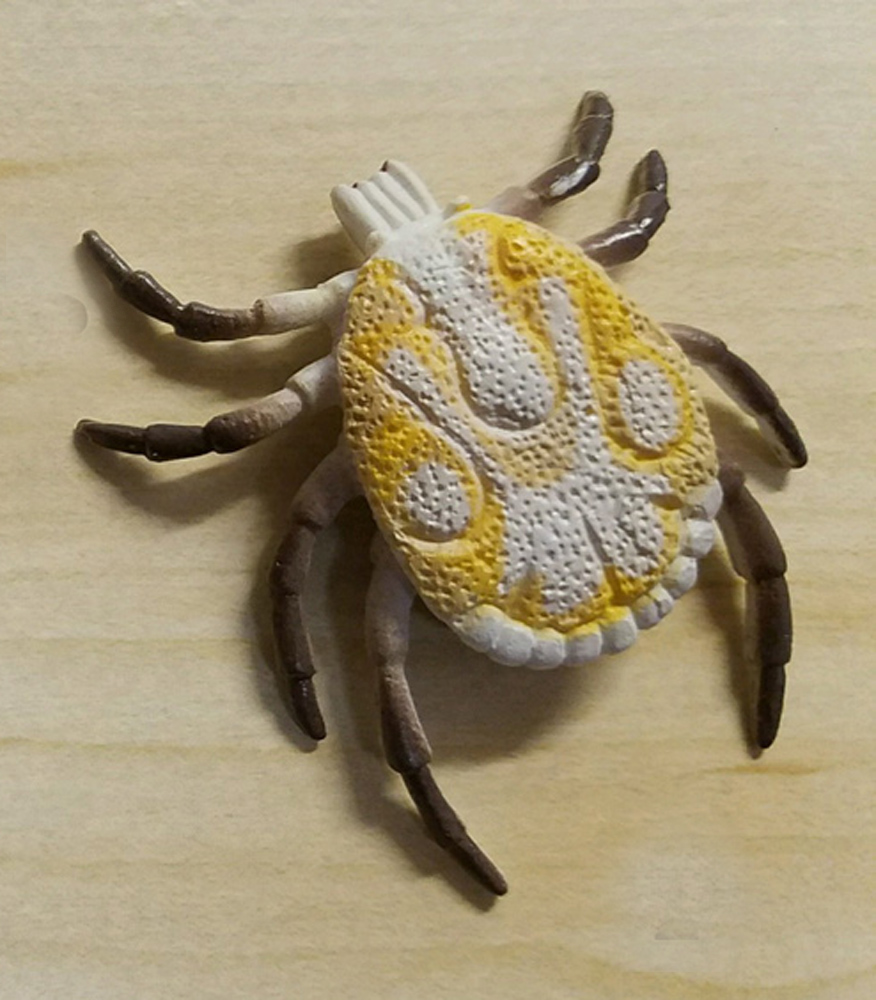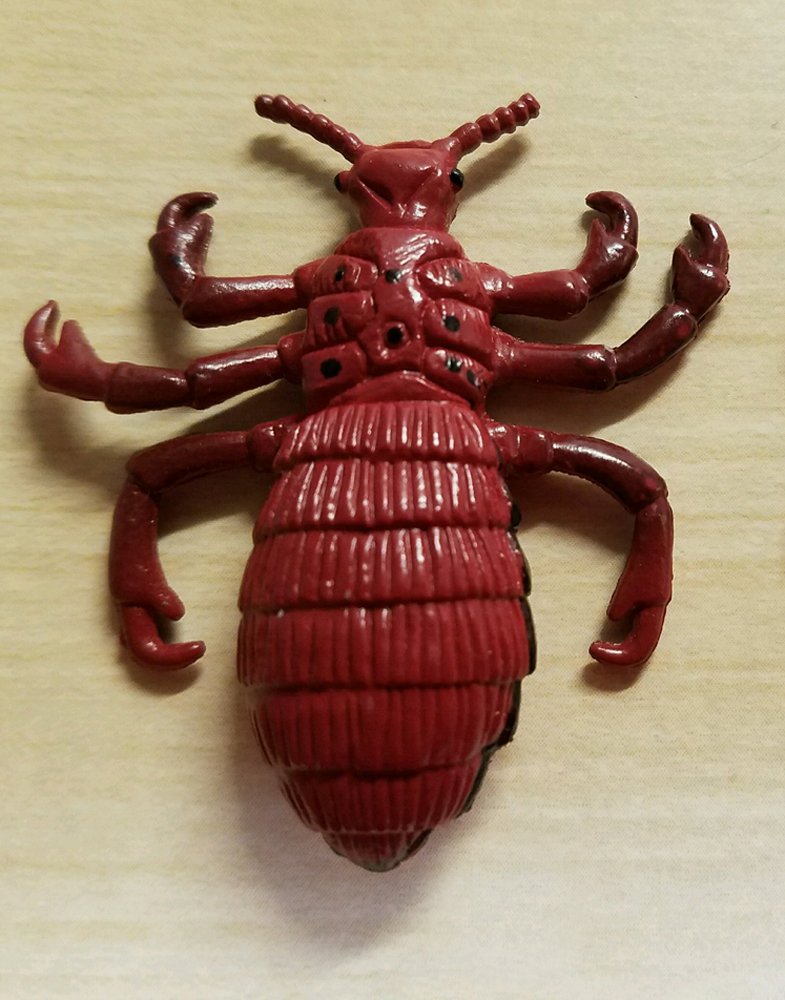OK folks, here we are. I was finally able to complete this holiest of Holy Grail sets, thanks to STS forum member NMR_Okapi who found me the last missing figure! Most of you who follow me on the Blog and forums know I am a professional parasitologist, so it should be no surprise that this has been one of the most sought-after sets for someone like me. This set features eight ectoparasites/medically-important arthropods that was released alongside other theme-based sets by Play Visions in the late 1990s; specifically, this set came out in 1996 (one of their earlier ones, surprisingly).
As with all Play Visions figures, they are stamped with the common name, year, and ‘PV’ logo on the bottom. Any given figure is on average 5.0-5.5 cm across their greatest widths; these all represent very small to microscopic organisms, so I will not be calculating scale.
It is not common, but every now and then, Play Visions stamps a figure with an obviously incorrect name. This is rare, but there are two examples of this in this set, and I will address them below.
Group pic:

On to the figures in no particular order:
Scabies Mite (human itch mite), Sarcoptes scabiei
Scabies is a highly-contagious disease of the skin caused by the human itch or scabies mite, S. scabiei. It occurs worldwide. There is a severe form of the disease seen primarily in immunocompromised, institutionalized, and elderly patients called ‘crusted’ or ‘Norwegian’ scabies, characterized by hyperkeratotic plaques covering the body. This is the only ‘toy’ of S. scabiei I am familiar with (expect most in this set to be rare or unique), although GPI Anatomicals made a large museum-quality replica in their Canine Skin Parasites display set.

Dust Mite, Dermatophagoides sp.
Believe it or not, this is not the first dust mite to appear on the Blog; I had previously reviewed the model by Wolff Marketing Group that was sold as a premium to promote the allergy medicine Zyrtec. And I still have a third figure in my collection by Sbabam! This is probably the most unusual in the set because the ‘buggy’ eyes make it appear more cartoony than others in the set. Dust mites are not ectoparasites; their medical importance comes from allergic reactions to the mites and their feces.

Soft Tick, Ornithodoros sp.
This is the first figure that was misidentified. This figure is labeled as a ‘chigger’ but the morphology clear supports that of a soft tick. Besides, chiggers are only parasitic in the larval stage, which would have only six legs, and with this figure having eight legs it is clearly an adult or nymph. Most soft ticks are difficult to identify as adults, and the designation of Ornithodoros is my own, since they are the most medically-important genus in the family, being the vectors of tickborne relapsing fever spirochete bacteria.

Hard Tick, family Ixodidae
This is another one that is technically misidentified, depending on how strict you apply the term ‘deer tick’. This figure is marked as a deer tick, which usually implies a member of the genus Ixodes. However, in this figure there are two morphologic features which easily rule-out Ixodes: the presence ornate (white) markings on the dorsal surface and the presence of festoons (those little grooves along the posterior end). If one insisted on assigning a species-level ID to this figure, I would recommend the South African bont tick, Amblyomma hebraeum, based on the pattern of the maculae. Amblyomma hebraeum occurs in the southeastern Africa where it vectors the livestock pathogen Ehrlichia ruminatium (heartwater disease).

Bed Bug, Cimex lectularius
This one is fairly straight forward and one of only two bed bug toys I am familiar with, the other being a mini figure by Club Earth in the Backyard Bugs collection (I have suggested it would make a great Incredible Creatures figure for Safari for years now…). I have a second bed bug in my collection, but that was a custom by Paleo-Creatures (Jetoar on the forums). Bed bugs occur nearly worldwide as nuisance pests. They do not vector diseases to humans.

Head Louse, Pediculus humanus capitis
Pediculus humanus is the human head-and-body louse. There are two subspecies, the body louse, P. h. humanus, and the head louse, P. h. capitis. This figure is specifically marketed as the latter. The two subspecies are actually quite different in their biology. The head louse spends its entire life cycle (egg to adult) on human hair and does not vector any disease-causing agents. The body louse however, spends most of its time off the host, only migrating over to feed, and transmits agents responsible for louse-borne relapsing fever, trench fever, and epidemic typhus. I have two additional figures of this species.

Crab Louse (pubic louse), Pthirus pubis
The term ‘pubic’ louse is somewhat of a misnomer, as they can also occur on eyelashes, eyebrows, and chest and facial hair on men. They are adapted to living on coarse hair, which includes the pubic region, but also the other aforementioned sites. This louse is more of a social stigma; they do not transmit disease. They also do not survive long off the host, so if someone says they got it from a toilet seat, or sharing an item of clothing, etc. they are probably wrong ;-). By the way, there is an obvious anatomical mistake with this figure. They are called ‘crab’ lice because they are shaped like crabs; they do not have crab-like claws as depicted here. Each leg has a single claw, which should be much larger on the middle and hind legs than on the front legs. Surprisingly this is not the only crab louse figure; Kaiyodo made a nice one in their Capsule Q Museum line.

Cat Flea, Ctenocephalides felis
The cat flea, Ctenocephalides felis, and the related dog flea, C. canis, are not host specific and will bite each other’s hosts as well as humans. Household infestations are usually more common with cat fleas, however. Cat fleas can vector some bacteria (not the plague bacillus, at least not efficiently) and can harbor tapeworms that people (usually children) can get when accidentally ingesting the infected flea (e.g., a child kissing a pet cat and ingesting the flea). This is the only figure I have seen specifically marketed as a cat flea, but other flea toys, including the Incredible Creatures model by Safari, is in the genus Ctenocephalides. This figure is too ‘fat’ for a flea, but it was probably necessary to prevent damage in production and play.

Well, there you have it. A review of a set of ectoparasites and medically-important arthropods. If you are a collector o bizarre taxa, these are for you. Unfortunately like many PV figures, they are very hard to find these days. I have gotten mine through trades or purchases from other collectors.
Disclaimer: links to Ebay and Amazon on the AnimalToyBlog are affiliate links, so we make a small commission if you use them. Thanks for supporting us!




Brilliant! I never would have guess that this set existed. It seems like Play Visions was doing a lot of interesting stuff in the 90’s, I wish someone would fill their niche. Safari could do it with their TOOB figures, but alas. Great review and a really cool set. I had fun reading this one.
probably the closest thing we have to such sets these days are Eikoh miniatureplanet and Yowie Group, which in 20 years will probably be as sought-after as PV 😉
Get the pesticides out, quick.